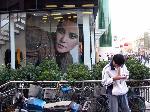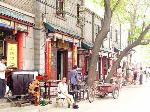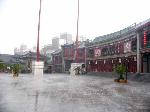- Getting around Lijiang. Dont stay in the Old Towns more than 2 days, there is nothing to do. KRISS Oct 9, 2013 05:46
- 2013 Beijing Temple Fair BENNYLAU Feb 26, 2013 03:29
- Malaysian traveling from KUL - LAX vis Shanghai PVG ZATI_DY Jan 3, 2013 20:15
Three Streets
- Views: 5197
- |Vote: 1 0
- |Add to Favorites
- |Recommend to Friends
Binjiang Dao
It's late evening, the sun's about to set and Tianjin's central pedestrian mall, Binjiang Dao, is crawling with people like a nest of ants. Folk on the street are chattering with excitement or bartering furiously with stubborn merchants; pop music barking from storefront loudspeakers mix melodies with neighbouring businesses doing the same; young shop attendants stand at the entrances of clothing boutiques clapping to attract customers and calling out their latest specials; peddlers and fashionable teenagers bustle past each other in a brash, typical Northern Chinese rush. Above them all, a huge billboard leans over the crowds: pop idol Wang Fei stares coldly, enchantingly, out over the human chaos, her body captured in her clothing, alone in her commercial; and in her quiet gaze the mercy of the Buddha.
The old Catholic church with its patchwork quilt coloured bricks is poised like a city gate at the southern end of the mall, commanding the street as if yearning for genuflection from the faithful – but in the still, summer heat the electric dynamism of the jostling bodies urges to the north, compelling the pedestrians to drift up its artery, flushing customers into discount stores and labyrinthine side alleys of cut-price clothing. Get caught in the current and you'll find yourself enclosed by these side malls, tugged at by store owners pointing entreatingly at their shelves of shirts and cotton bras, knock-off designer jackets and lacy sequinned tops. Insist on 10% of the price they quote and you may well walk away with the goods.
Couples, farther up the mall, are clasping hands and arguing hotly. She frowns and reaches into her purse, and buys a stick of toffeed grapes, as her flustered boyfriend pushes aside her money and offers his own. Everywhere on the street, people are chewing on toffee – chips of toffeed nuts and sesame seeds, whole toffeed bananas, puffed honeycomb and skewers of crab apples. The sky is dim but the street is bright with the lights of open-late traders, glowing trinkets sold at the roadside and wrapped around the wrist, and a starfield of cellphone displays wavering and glittering as Han girls with puffy hairdos transmit text messages between them, like thoughts flicked across the synapses of Tianjin's mind. And thus the crowd shifts in entropic patterns, dissolving the toffee sugars on their tongues as they snack on centuries-old sweet Tianjin recipes.
Take a left up at Heping Road where the imposing marble walls of the old colonial buildings close the sky above you in a gaudy display of European wealth. The buildings are colonised themselves by department stores and banks, and proud, huge Chinese characters cling to their sides like viruses. Small, tram-like vehicles parp the mass of pedestrians out of their paths, shuttling along the mall with their loads of wearied, older passengers cradling their huge paper sacks of bargains. As it gets darker, the air seems to thicken as the people fade farther down and congregate at the clothes markets. It's the steam from the sweets carts as the toffee smoulders in iron tubs. Now the French stonework seems cold and divorced from its history, and the only light I see is from a glass front from behind which Wang Fei stands again in her display, her smile here vaguely different somehow, as if welcoming me home.
Shenyang Dao
In the bright afternoon sun, in the leafy backstreets of central Tianjin, the antiques market at Shenyang Dao sprawls lazily in the warm air, as if the rows of old stores have been spilt from a pitcher and left carelessly in the pattern in which they fell. They're tough to find: every time I come to Tianjin I make wrong turns along the warren of rural streets and have to backtrack to find my way again. All the homes are old here, and one rather fancies that these parts of Tianjin now look much as they did then, when the east of the city crawled with colonists from twelve different nations, all taking themselves to be lords over the local Chinese, who were quietly ignoring them in lanes like these.
Turn a corner, and you're there – along the roadside, tables and ground level displays of bangles, jade ornaments, old photos and magazines and musical instruments and eyeglasses, jewellery boxes and faded portraits of Chairman Mao. Sitting – no, lying back in old chairs with their shirts rolled up over their beer bellies, the proprietors themselves call distractedly as I pass. I pick up a rusted badge with a red star visible under the cracked enamel – within seconds the laze in the air lifts smartly as a chubby housewife races from her position within the store and begins to encourage me to buy this valuable item. I smile politely and set it back as she shows me other Socialist memorabilia – gold Mao head clips, large torn posters of lantern-jawed workers clutching red books, all authentic leftovers from less comprehensible times. I pick up a packet of revolutionary ballet postcards – supple, curvaceous ballerinas poised mid-pirouette and toting automatic rifles and hand grenades. The colours are staggering – I ask for a price, and am quoted sixty yuan. I balk and try to haggle, but the gentleman at the counter is resolute – "you're holding a piece of our country's history." I reluctantly put them aside and begin to walk away, before he calls me back: "OK, seven."
The sound of a Chinese two-stringed violin draws me to a small instrument store, but although the walls are covered in hanging Erhu violins, the music is coming from a gramophone record, playing from a hundred year-old sound-system through a huge amplifying metal horn. It's intriguing, and I browse through the old instruments and pick up a tight-skinned hand drum. I lift it to my ear and tap the skin a few times with my fingers: the owner tiptoes across to where I am standing and softly positions my hands correctly on the barrel of the drum, and demonstrates how to strike it properly. He nods happily as I beat the drum in counterpoint to the poignant strains of Erhu violin lullabies swelling in the antique air of the little shoproom.
Ancient Culture Street
Tianjin's Ancient Culture Street is a recreation of a Qing period marketplace with broad marbled avenues and stone houses with authentic stylised tiled roofs. It looks like the set of a movie, which is perhaps its chief drawback - real Chinese streets, the ones that you can still see in Tianjin's older alleyways and twisting hutongs, are noisy and messy and randomly chaotic; the Ancient Culture street is spotless, beautifully laid out and noisy only with tourists and locals seeking bargains on imitation traditional items.
Past the racks of cheap satchel bags I find a shop selling jade trees and crystal balls of varying size and clarity; the same store sells banners of traditional Chinese art, wooden staffs and elegantly fashioned swords. Next door, colourful rails of Cheongsam dresses shaped into the mouth-watering curves of slender women, their embroidery shimmering in the electric light, hang smartly before dangling scarves and braided hair decorations, ribbons and ornaments. I browse through a basket of purses and pincushions and pick up a Chinese Muslim cap studded with glass jewels, on the back of which has been sewn the image of a Giant Panda.
As in other parts of Tianjin, snack food is in abundance - half the reason why local Chinese come to visit this place is to gorge themselves with the snacks the city is famous for. Preserved fruits, twisted crunchy Mahua biscuits pressed with icing and rock sugar, more sesame seed toffee and cakes of pear juice toughened with honeycomb and sold in bright yellow discs - dozens of calculating visitors are descending on the stalls of traditional bonbons, filling small plastic bags, gathering armfuls of decorative sweets boxes intended for use as corporate presents, arguing, as always, about the price. I order a bowl of what could be reconstituted yoghurt or cream cheese: I select a small sachet of flavoured powder (there's everything from chocolate to pineapple to coffee) and it's mixed in a cardboard bowl with a cupful of hot water until the brightly coloured solution congeals into a thick paste. I add a few nuts from a rack and try it out - unexpectedly, it's absolutely delicious.
It begins to rain, very suddenly - pours. The street swiftly clears as the tourists make to go, and many storefronts almost instinctively lock their doors. I stand beneath an arched doorway, but within minutes the rain's intensity doubles and a stream of rainwater makes its way towards my boots. I splash across an open courtyard and buy a ticket to the only place that seems to have shelter - the Tianhou temple, just three kuai. Perhaps the street is poorly designed, for it floods quickly and by the time I have gotten myself into a prayer room the water is already several centimetres deep.
It's dim, and there are other tourists huddled around the room, seated on the knee-rests intended for worship of the enshrined Buddha; in this case, the goddess of the sea. The sunlight is poor, filtered through the thick, dark grey rain clouds, and none speak, for amongst the pretences of the Ancient Culture street, this one room, with its simple offerings of fruit and incense smoking silently before its idols, is the most real thing any of us have seen yet today.






 Copyright © 1998-2026 All rights reserved.
Copyright © 1998-2026 All rights reserved.